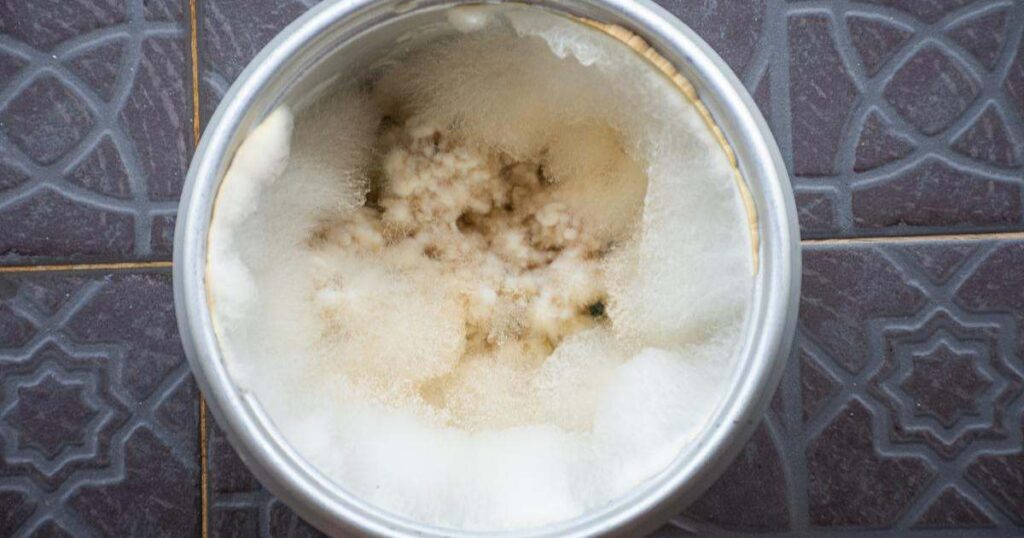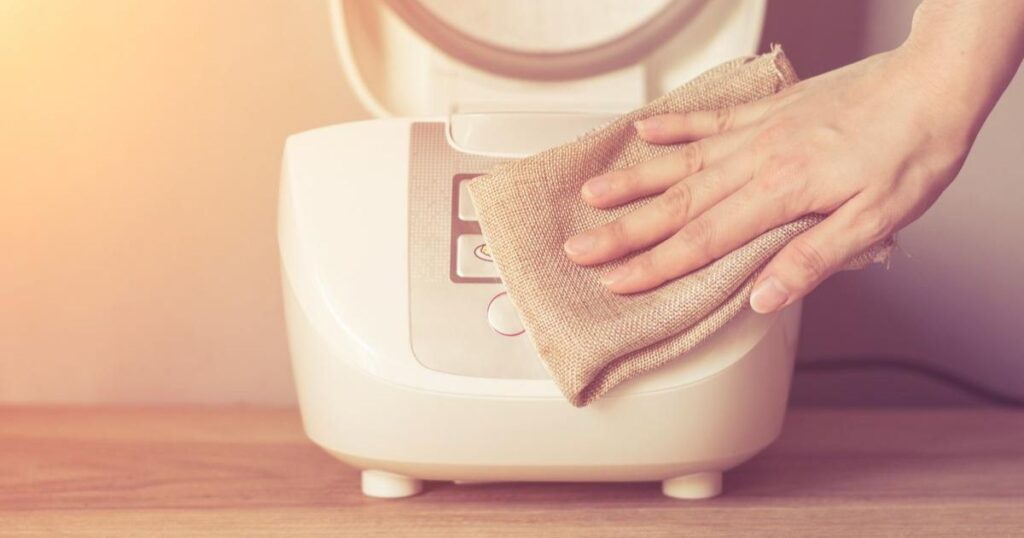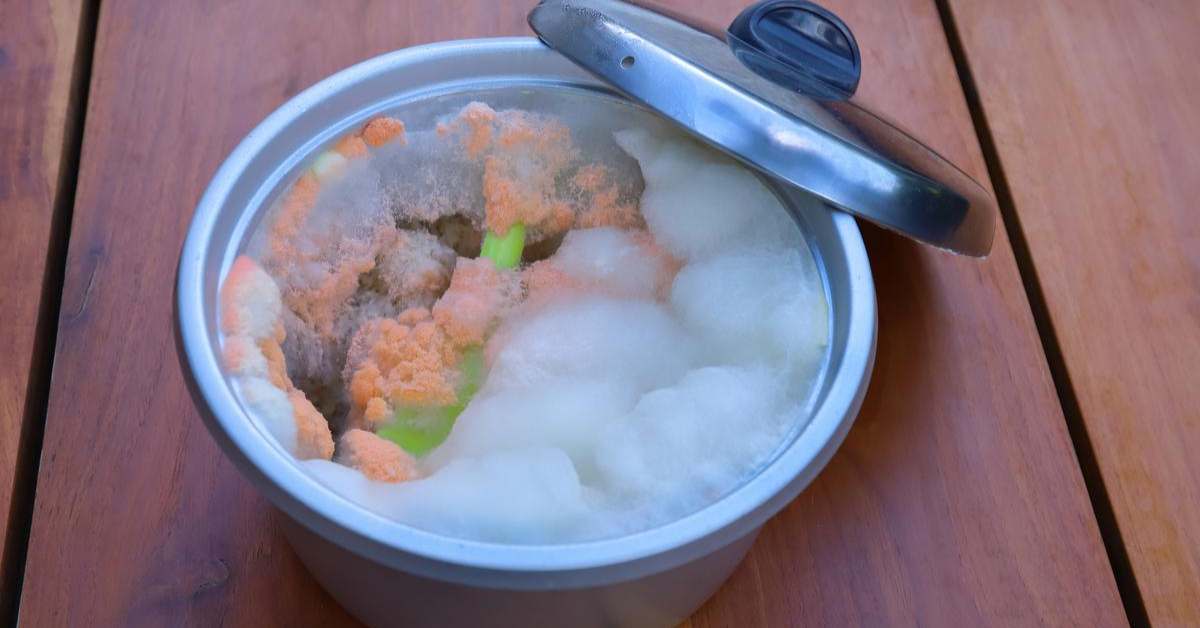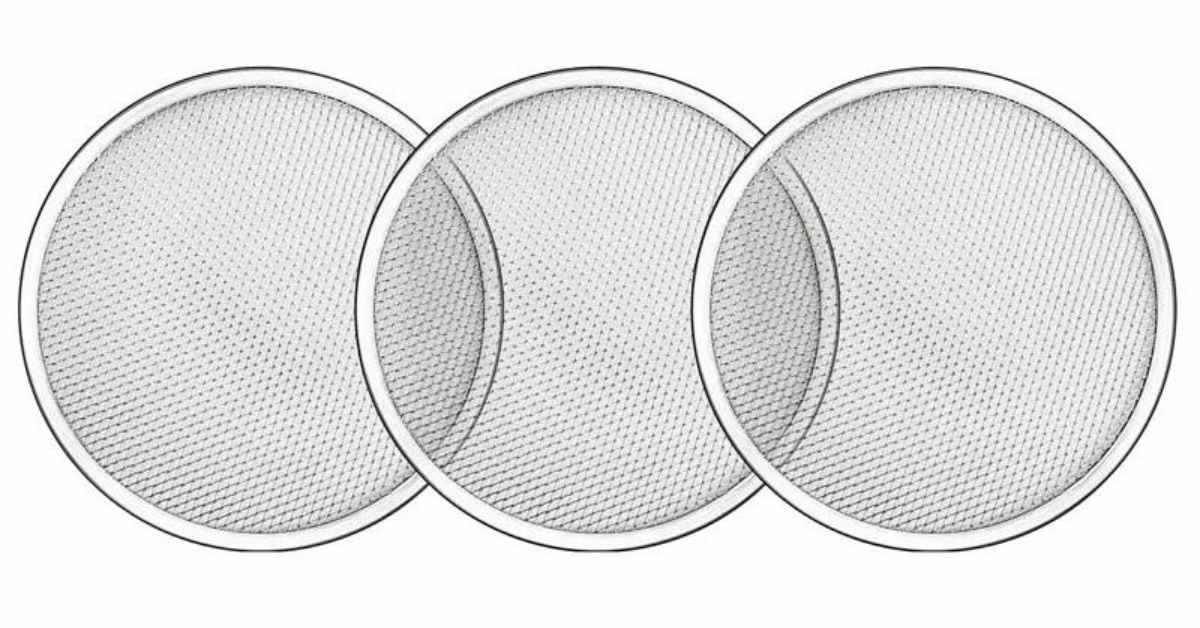Cleaning a moldy rice cooker can be daunting, but it becomes much easier and more manageable with the right approach. Mold can grow in damp and dark environments, and a rice cooker provides the perfect breeding ground if not properly maintained.
In this comprehensive guide, we will walk you through the step-by-step process of how to clean moldy rice cookers effectively. Whether you’re a novice or an experienced cook, following these simple instructions will ensure your rice cooker is mold-free and ready for safe and delicious meals. Let’s dive into the most accessible guide to cleaning a moldy rice cooker.
Table of Contents
ToggleWhy Do Rice Cookers Get Moldy
Mold growth in rice cookers can be a common issue, and understanding the reasons behind it is crucial for effective prevention and maintenance. There are a few key factors that contribute to the development of mold in rice cookers:
Moisture: Rice cookers create a warm and humid environment during cooking, promoting moisture retention. If the residual water is not properly dried after use, it provides an ideal breeding ground for mold.
Food Particles: Leftover food particles, especially rice grains, can accumulate in hard-to-reach areas of the rice cooker. These particles can trap moisture and provide nutrients for mold growth.
Lack of Cleaning: Regular cleaning is essential to prevent mold growth. After each use, you must thoroughly clean the rice cooker, allowing mold spores to thrive and multiply over time.
Improper Storage: Storing a rice cooker without proper ventilation or in a damp area can contribute to mold growth. Ensuring the rice cooker is completely dry before storage is essential.
Understanding these factors will help you take necessary precautions and adopt proper cleaning practices to keep your rice cooker mold-free. The following sections outline effective methods to clean and maintain your rice cooker, ensuring a daily hygienic cooking experience.
What Are the Signs of Mold in Rice Cookers

Identifying the presence of mold in your rice cooker is crucial for maintaining a healthy cooking environment. Here are some common signs that indicate the presence of mold:
- Foul Odor: A strong, musty smell emanating from your rice cooker is a telltale sign of mold growth. If you detect an unpleasant odor even after thoroughly cleaning the range, mold has likely taken hold.
- Discoloration: Mold often appears as dark spots or patches on the inner surfaces of the rice cooker. Check for any unusual discoloration that differs from the typical appearance of the cooker’s interior.
- Slimy Texture: When mold develops, it can create a messy or fuzzy surface texture. If you notice any unusual sliminess or fuzziness on the inner pot or other parts of the rice cooker, it indicates mold growth.
- Allergic Reactions: Mold can trigger allergic reactions in some individuals. If you or your family members experience unexplained allergic symptoms like sneezing, coughing, or itching after using the rice cooker, it could be due to mold contamination.
- Visible Spores: In severe cases, you may see visible mold spores on the surfaces of the rice cooker. These can appear as tiny black or green specks.
If you observe any of these signs, it’s essential to take immediate action to clean and disinfect your rice cooker. Mold can negatively impact the quality and safety of your cooked rice and pose potential health risks. In the following sections, we will guide you through thoroughly cleaning and removing mold from your rice cooker.
Is it Safe to Cook Rice With Molds?
Cooking rice in a mold-infested rice cooker is not recommended due to potential health risks. Mold can produce mycotoxins, which are harmful substances that can contaminate food. These toxins can cause allergic reactions, respiratory problems, and even more severe health issues if consumed in large quantities.
When rice is cooked with mold present, there’s a higher chance of these toxins contaminating the grains. Even if you remove the visible mold before cooking, the toxins may have already spread throughout the rice, making it unsafe for consumption.
Furthermore, mold can affect the taste and texture of cooked rice, resulting in an unpleasant dining experience. Moldy rice can have an off-putting flavor and an undesirable consistency.
To ensure the safety of your meals and maintain optimal health, it’s best to discard any rice or food that has been cooked in a moldy rice cooker. Instead, thoroughly clean and disinfect the appliance before using it again.
Materials Needed to Clean Moldy Rice Cookers
Cleaning a moldy rice cooker requires specific materials to ensure effective mold removal and maintain a safe and hygienic cooking environment. Here is a list of materials you will need:
- Rubber gloves: Protect your hands from direct contact with mold and cleaning agents by wearing rubber gloves.
- White vinegar: Vinegar is a natural and effective cleaning agent that helps to kill mold and remove stains. It is also safe to use on most surfaces of the rice cooker.
- Baking soda: Baking soda is another eco-friendly cleaning agent that helps to eliminate odors and remove stubborn stains.
- Microfiber cloth or sponge: Use a microfiber cloth or sponge to wipe down the surfaces of the rice cooker. These materials are effective at trapping and removing mold spores.
- A toothbrush or small brush: A toothbrush or small brush can be used to scrub hard-to-reach areas and remove any stubborn mold.
- Water: Clean, warm water is necessary for rinsing the rice cooker and ensuring that all cleaning agents are thoroughly removed.
Eco-friendly and Safe Alternatives to Cleaning Products
If you prefer to use eco-friendly and safe alternatives to commercial cleaning products, consider the following options:
- Lemon juice: Lemon juice has natural antibacterial properties and can help remove mold and stains. Dilute it with water and use it as a cleaning solution.
- Hydrogen peroxide: Hydrogen peroxide is an effective mold killer and can be used as an alternative to vinegar. Dilute it with water and apply it to the affected areas.
- Tea tree oil: Tea tree oil is a natural antifungal agent that can help inhibit mold growth. Mix a few drops with water and use it as a cleaning solution.
Remember to follow the instructions carefully when using these alternatives and test them on a small, inconspicuous area of the rice cooker before applying them to larger surfaces. Always prioritize safety and proper ventilation when cleaning to avoid any potential risks.
Now that you have the necessary materials let’s move on to cleaning your moldy rice cooker effectively.
How to Clean a Moldy Rice Cooker: Step-by-Step Guide

Cleaning a moldy rice cooker requires a systematic approach to remove mold and restore its cleanliness thoroughly. Follow this step-by-step guide to clean your moldy rice cooker effectively:
Step 1: Safety Precautions
It’s crucial to prioritize safety when dealing with mold. Here are some essential safety precautions to consider:
- Protective Gear: Wear rubber gloves to protect your hands from direct contact with mold and cleaning agents.
- Ventilation: Clean the rice cooker in a well-ventilated area or open a window to allow proper air circulation during the cleaning process.
Step 2: Disassembling the Rice Cooker
To clean the rice cooker thoroughly, you must disassemble specific components. Follow these tips for safe and effective disassembly:
- Unplug the Rice Cooker: Ensure the rice cooker is unplugged from the power source before dismantling it.
- Remove Inner Pot: Remove the inner pot and separate it for cleaning.
- Detach Accessories: If your rice cooker has additional accessories like steam trays or lids, remove them for individual cleaning.
Step 3: Soaking in Vinegar and Water Solution
Using a vinegar and water solution is an effective way to kill mold and remove stains. Follow these steps for soaking the rice cooker:
- Prepare the Solution: Mix equal white vinegar and water in a bowl or basin.
- Submerge the Components: Place the inner pot and other removable parts into the vinegar and water solution, ensuring they are fully submerged. Let them soak for about 30 minutes to loosen any mold or residue.
Step 4: Scrubbing With a Soft Brush
Scrubbing the rice cooker with a soft brush helps to remove any remaining mold and stains. Consider these suggestions:
- Select a Soft Brush: Choose a brush with soft bristles that won’t scratch or damage the surfaces of the rice cooker.
- Scrub the Interior: Gently scrub the interior surfaces of the rice cooker, paying extra attention to areas with visible mold or stains. Use circular motions to dislodge any stubborn residue.
Step 5: Rinsing and Drying
Thorough rinsing and drying are essential to ensure a mold-free and ready-to-use rice cooker. Follow these tips:
- Rinse with Water: Rinse all the components under clean, running water to remove any vinegar residue or loosened mold particles.
- Dry Completely: After rinsing, ensure all parts are arid before reassembling the rice cooker. Use a clean cloth or allow them to air dry in a well-ventilated area.
Following these steps, you can effectively clean your moldy rice cooker and restore its hygiene. Remember to practice regular cleaning and maintenance to prevent mold growth in the future.
How to Prevent Mold Growth in Rice Cookers
It is essential to take preventive measures to ensure a mold-free and hygienic rice cooking experience. Follow these tips to prevent mold growth in your rice cooker:
Thorough Cleaning: Clean your rice cooker thoroughly after each use. Remove leftover rice or food particles from the inner pot and other components. Pay attention to hard-to-reach areas where moisture and food residue can accumulate.
Drying Properly: After cleaning, ensure that all parts of the rice cooker are arid before reassembling or storing. Wipe moisture with a clean cloth or let the parts air dry to prevent mold growth.
Ventilation: Store your rice cooker in a well-ventilated area. Avoid keeping it in a closed cabinet or a damp environment, as this can create a favorable condition for mold growth. Proper air circulation helps to prevent moisture buildup.
Regular Inspections: Periodically check your rice cooker for any signs of mold growth or unusual odors. Immediately disinfect the rice cooker if you notice any discoloration, slimy texture, or moldy smell.
Use Dry Measuring Cup: When measuring rice and water for cooking, use a dry measuring cup. Moisture in the measuring cup can contribute to the overall moisture content in the rice cooker, increasing the chances of mold growth.
Avoid Storing Wet Rice: Never store sticky rice in the cooker. Always transfer cooked rice to a separate container and refrigerate it promptly. Holding rice in the range can create a wet environment that promotes mold growth.
Regular Maintenance: Follow the manufacturer’s instructions for routine maintenance and care of your rice cooker. This may include descaling or deep cleaning procedures to prevent mold and mineral buildup.
By implementing these preventive measures, you can significantly reduce the risk of mold growth in your rice cooker and ensure a safe and clean cooking environment.
Tips for Maintaining a Clean Rice Cooker
Maintaining a clean rice cooker prevents mold growth and ensures optimal performance and longevity. Here are some additional tips for maintaining a clean rice cooker:
Wipe the Exterior: Regularly wipe the exterior of the rice cooker with a damp cloth to remove any dust or stains. This helps to keep the appliance clean and presentable.
Use Non-Abrasive Cleaners: When cleaning the exterior surfaces of the rice cooker, use non-abrasive cleaners that are safe for the specific material of your appliance. Avoid harsh chemicals or abrasive scrubbers that can damage the finish.
Clean Accessories Separately: If your rice cooker comes with additional accessories like steam trays or lids, clean them separately according to the manufacturer’s instructions. This ensures that all components of the rice cooker are appropriately maintained.
Follow Storage Recommendations: Following the manufacturer’s recommendations when storing the rice cooker. Some models may have specific instructions on how to keep the inner pot, accessories, or the entire unit to prevent damage or mold growth.
By incorporating these maintenance tips into your routine, you can keep your rice cooker in top condition, prolong its lifespan, and enjoy mold-free cooking experiences for years.
FAQs About How to Clean Moldy Rice Cooker
Is it safe to cook rice with molds?
No, it is not safe to cook rice with molds. Mold can produce harmful mycotoxins that contaminate the rice and pose health risks if consumed. Discarding moldy rice and cleaning the rice cooker thoroughly before cooking is essential.
Is mold killed by cooking?
While cooking can kill some types of molds, it may not eliminate all their toxins or spores. It is best to avoid cooking with moldy ingredients to ensure food safety.
Can I use bleach to clean a rice cooker?
Using bleach to clean a rice cooker is not recommended. Bleach is a strong chemical that can be harsh and leave behind a residue—Use safer alternatives like vinegar or mild dish soap for cleaning the rice cooker.
What is the black mold in rice?
The black mold commonly found in rice is called Aspergillus oryzae. It is a fungus that can grow on improperly stored or damp rice. Consuming rice contaminated with black mold can lead to health issues, so it is essential to discard moldy rice.
Can you put vinegar in a rice cooker?
Putting vinegar directly in the rice cooker while cooking rice is not recommended. Vinegar can affect the flavor and texture of the rice. However, you can use vinegar as a cleaning agent to remove mold or stains from the rice cooker’s inner pot and other removable components.
Should we wash the rice cooker?
Yes, washing the rice cooker regularly is essential to maintain cleanliness and prevent the growth of mold or bacteria. After each use, clean the inner pot, lid, and other removable parts with warm soapy water. Wipe the exterior of the rice cooker with a damp cloth. Regular cleaning will ensure a safe and hygienic cooking environment.
Conclusion
In conclusion, keeping your rice cooker clean and mold-free is crucial for safe and healthy rice cooking. Cooking rice with molds is not safe due to the potential presence of harmful mycotoxins. Cleaning the inside of the rice cooker regularly using safe and effective methods, such as vinegar and water solution, and proper scrubbing techniques help eliminate mold and maintain a hygienic environment.
Additionally, preventive measures like thorough drying, proper ventilation, and regular inspections can help prevent mold growth in the rice cooker. Following these guidelines ensures that your rice cooker remains in optimal condition, allowing you to enjoy mold-free and delicious rice every time.






